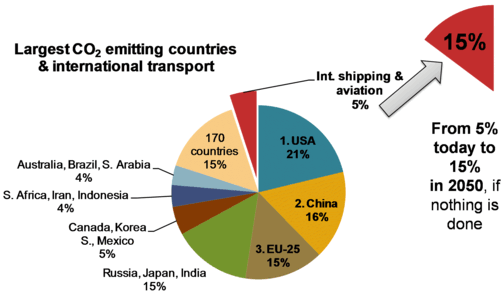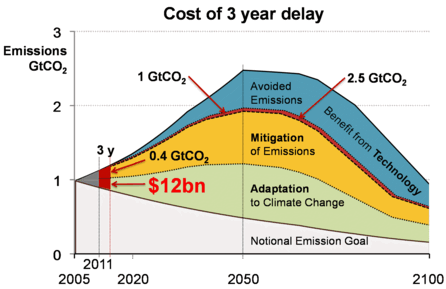Case for (affordable) Action
 International maritime CO2 emissions accounts “only” for circa 3% of total emissions from fossil fuels. They are #6*, if compared with the largest emitting nations. Their share can more than double by 2050.
International maritime CO2 emissions accounts “only” for circa 3% of total emissions from fossil fuels. They are #6*, if compared with the largest emitting nations. Their share can more than double by 2050.
Action to reduce shipping CO2 emissions and contribute to tackle climate change can be ambitious yet affordable.
* Based on the most recent estimates from 2007 of circa 0.9GtCO2 (maritime emissions are now #6 after emissions from the United States, China, Russian Federation, Japan and India).
International emissions are exempt from taxes, and unaffected by the Kyoto Protocol.
If nothing is done, the total emissions from international maritime transport and aviation will in 2050 reach 15% of all emissions from fossil fuels. This will in effect triple their current share estimated at 5% as shown below. The pressure for action is therefore growing very rapidly (see for instance a recent article on: True scale of C02 emissions from shipping revealed). It seems unavoidable that both maritime and aviation must contribute to global emission reductions.
In short, emissions from international transport are far from small, and grow rapidly ....
Case for Affordable Action
The shipping should contribute fairly to action on global warming, and it could be done in an affordable manner. The arguments for a flexible and lowest cost approach for shipping are numerous. Shipping is:
- the most efficient mode of transport and has a very low energy consumption
- vital to economic growth, as it is responsible for more than 90% of volume of goods transported internationally
- having a cooling effect rather than a warming one on the world climate
Cost of delay
Delaying action is very expensive. Based on our calculations, shown below, the environmental cost of 3 year delay is estimated at excess of 1.4 - 1.8 GtCO2 by 2050 alone. This is equivalent to 1.5 years of maritime emissions.
The cost of delay to the developing countries is $12bn of financing for adaptation to climate change not made available.

Note: calculations for 20-50 emission goal from 2005 baseline.
Details will be unveiled in Bonn in mid June 2008. Calculations for slightly different different assumptions are available in the Case for action discussion document ![]() (0.2 MB) originally prepared for the IMO MEPC 56 in July 2007.
(0.2 MB) originally prepared for the IMO MEPC 56 in July 2007.
An ambitious yet affordable reductions are achievable
- Shipping could and should:
- adopt as soon as possible an ambitious, long-term notional emission reduction target, and align it later once the post-2012 climate change regime is agreed
- invest in the cheapest short-term emission reductions (very likely to be primarily outside of shipping for the reasons above)
- invest in the long-term reductions in the sector itself.
